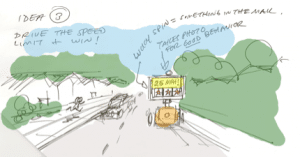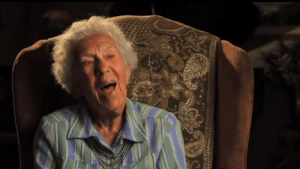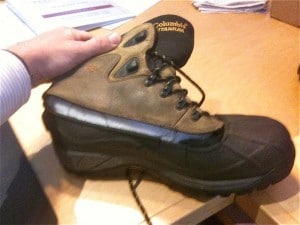 Want to strengthen your green brand? Try to lighten up a bit.
Want to strengthen your green brand? Try to lighten up a bit.
We’re hardwired for fear. No matter how irrationally it functions, it’s our primary motivator.
Fear helped our ancestors avoid being a saber-toothed tiger’s brunch.
It caused seemingly good, God-fearing Christians to barbecue people at the stake. How else could Congress sell escalating defense budgets at the expense of funding our schools?
Is fear losing its grip?
I recently attended the Sustainable Brands Conference in Monterrey, CA, and the one theme that dominated the three-day event was the concept of having fun. Optimism and a youthful sense of silliness were a close second and third. Big brands were everywhere, including Coca-Cola, Kimberley Clarke, SAP, Nike, Adidas, HP, and Park&Co. Did I mention that wild-eyed optimism was also abundant?
What large and small brands are finding is that consumers are so tired of feeling a lack of control with world events — what, with the collapse of Wall Street, spastic oil prices, never-ending Middle East conflicts and global warming — that they’re intensely focused on what they CAN control: their lives. Trust has vanished for authority figures and large organizations, and that includes anyone trying to sell them something.
The consumer has a greater voice now than ever before. And they’re using it. Look no further than the relatively peaceful revolutions in the Middle East sparked through the use of social media. Consumers are giving the finger to the status quo, and they are redefining the rules. Fear, in many respects, is losing its relevance. You can see it reflected in sentiments like this one from a young Nike wearer: “I’ve been living in code orange since I was 14. Give me a break.”
“I’ve been living in code orange since I was 14. Give me a break.”
The first rule of this new game is to find fun ways to involve your customers as you make an honest, concerted effort to better their world.
Dave Cobban, Nike’s Mobilization Director, presented a study showing how their young adult markets were emphatic about wanting a better world and implored Nike to help them create it in part through their products. Nike has responded.
Volkswagen’s “Fun Theory” was center stage, demonstrating how they crowdsource their customers to come up with the most engaging ideas to affect positive behavior change. I was fortunate to spend time with Kevin Richardson, this year’s winner of the Fun Theory contest with his “Speed Camera Lottery” concept. The stunt turned the negative loop of punishing speeders with tickets and fines into a positive loop of rewarding drivers who obey the speed limit.
Pay what you want
Taking consumer empowerment to a seemingly absurd new level, Panera Bread founder Ron Shaich introduced the Sustainable Brands crowd to the backward business model of letting people pay what they want at his restaurants. This “Take what you need, pay what you can” concept is based on the belief that people are generally good. Those who truly can’t afford a meal pay little to nothing. Those who can voluntarily pay their fair share and then some.
Gaming the system
No matter what you might think of the time-suck apparatus called “Farmville” or it’s hipper cousin “Angry Birds,” they are testaments to gamifying consumer engagement and making it fun. Civilization has been playing games as long as its been telling stories. Marketers are beginning to make cheat sheets on how to master this new trend of customer engagement. According to Gabe Zichermann, author of Game-Based Marketing, Inspire customer loyalty through rewards, challenges and contests, “Games are becoming the new mass media eating up the oxygen of engagement.”
“Games are becoming the new mass media eating up the oxygen of engagement.”
Games are so prevalent that sometimes you’re caught up in one and don’t even know you’re playing. This happened to me the other day during Safeway’s prostate cancer drive. That’s right. Your grocer is trying to make prostate cancer fun, or at least raising money for it. Zichermann’s rules of engagement were being played out both with the customers and the checkers who were responsible to keep the action moving. Like Safeway, brands you wouldn’t normally think of as fun and frolicking, including Wells Fargo and AT&T, are adopting games to motivate employees and retain customers.
 Michael Kim, a Harvard/Yale educated technologist, recently left his post as Microsoft’s director of XBox Live to create Kairos Labs and pursue his mission of helping people build positive habits through online games. His first venture, Livn.it, makes it fun to grow sustainable daily habits essential to living a better life. You compete with friends on Facebook to keep pace with the promises you’ve made yourself to lead a happier, healthier life.
Michael Kim, a Harvard/Yale educated technologist, recently left his post as Microsoft’s director of XBox Live to create Kairos Labs and pursue his mission of helping people build positive habits through online games. His first venture, Livn.it, makes it fun to grow sustainable daily habits essential to living a better life. You compete with friends on Facebook to keep pace with the promises you’ve made yourself to lead a happier, healthier life.
Time and again throughout the week at SB11, the story of having fun with your customers ran through nearly every presentation. They had us playing kickball in the foyer during breaks. And Specialized Bikes’ First Gear program gave away a dozen two-wheelers to the local Boys & Girls Club following its presentation, “A Hands on Experience with Brand Activation for Good.”
Finally, the winner of the Sustainable Brands Innovation Open was One World Futbol and its indestructible soccer ball that provides children in developing nations a ball that simply won’t deflate.
So all of these wonderful and disparate people, products, companies and causes got me thinking: are we doing all we can to inject fun and customer engagement into the brands we represent? If you’re a marketing partner at Park&Co, then you know all of this new inspiration is coursing through our creative veins right now, and it’s only a matter of time until we bring this even more refreshing brand of marketing fun to you and your enterprise.
Ready to play?













at 9:05 am
[…] This campaign captures that thought in a disturbing way. Kudos to those bureaucrats that made water conservation interesting and fun. […]